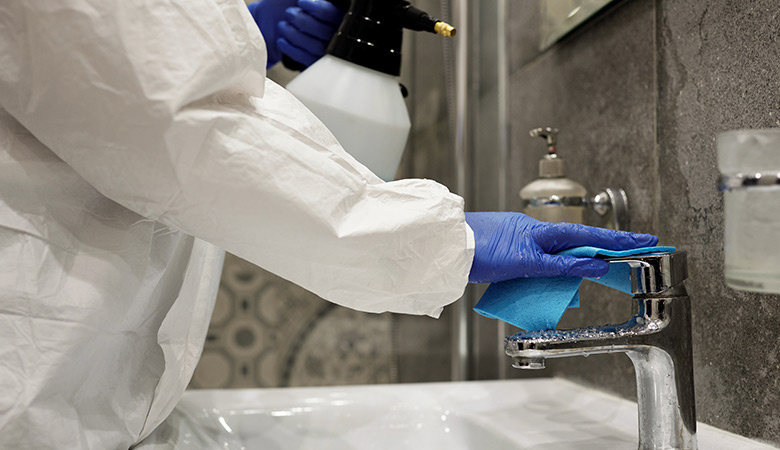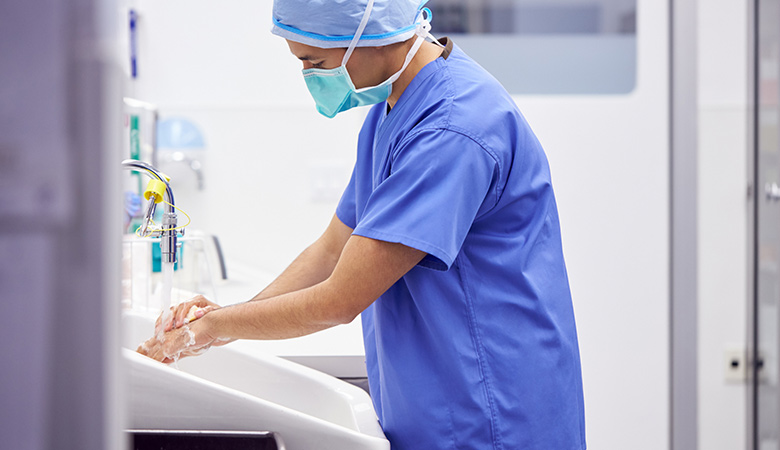Salud / Artículos
Desinfección, esterilización e higiene: ¿cuál es la diferencia?
Desinfección, esterilización e higiene son conceptos similares, pero con importantes diferencias prácticas. Descubre en qué consiste cada proceso y cuáles son sus diferencias.

 8 minutos de lectura
8 minutos de lectura
2022-01-27 17:08:00
Semejantes, pero no iguales. Desinfección, esterilización e higiene son conceptos similares, pero con importantes diferencias prácticas para empresas y hospitales. Conoce el significado de cada término, qué importancia tienen y cómo implementarlos.
¿En qué consiste la desinfección?
Todos los ambientes contienen bacterias y microorganismos, aunque muchos de ellos no son dañinos para los humanos. Pero los patógenos, los organismos que causan enfermedades, pueden ser peligrosos o incluso mortales. La desinfección es el proceso que elimina los microorganismos patógenos que se encuentran en objetos inertes.
El objetivo de la desinfección en las instalaciones industriales es garantizar que los utensilios, herramientas y equipamientos utilizados no propaguen enfermedades. Este proceso puede tardar entre 10 minutos y 12 horas, dependiendo de varios factores:
- La limpieza previa del objeto;
- La carga orgánica e inorgánica presente;
- El tipo y nivel de contaminación microbiana;
- La concentración y el tiempo de exposición al agente desinfectante;
- La naturaleza física del objeto (por ejemplo, grietas o bisagras);
- La temperatura y el pH del proceso de desinfección.
Con tantas variables en juego, el uso de equipamientos con capacidad de desinfección es fundamental para garantizar la seguridad de usuarios y profesionales.
¿Cómo conseguir un nivel de desinfección industrial?
Una máquina de lavado con capacidad de desinfección no solo limpia, también desinfecta el equipamiento para garantizar que su reutilización sea segura. Las máquinas de lavado preparadas para la desinfección industrial, como es el caso de MultiWasher, cuentan con diferentes ciclos que garantizan que cada utensilio es cuidadosamente desinfectado.
Este es el proceso que permite alcanzar los niveles deseados de desinfección industrial:
- La máquina de lavado enjuaga con agua fría cada utensilio para eliminar la suciedad;
- Seguidamente, añade la cantidad de detergente adecuada para la carga;
- Después, se eleva la temperatura del agua a unos 90ºC para iniciar el proceso de desinfección. La temperatura debe mantenerse a este nivel durante un tiempo determinado, dependiendo de la carga, para eliminar las bacterias restantes;
- La fase final es el secado. El sistema de filtración debe garantizar que no se transfieren microorganismos a los utensilios a través del aire caliente utilizado en este proceso.
Este proceso, si se ejecuta de forma controlada, automatizada y estable, ofrece importantes beneficios.
¿Quién puede beneficiarse de una buena desinfección?
Todas las empresas de la industria alimentaria pueden beneficiarse de un buen sistema de desinfección industrial. Lo mismo sucede en los hospitales, donde una cuidadosa desinfección de los equipamientos ayuda a prevenir la propagación de enfermedades infecciosas.
En ambientes como estos, donde cada minuto cuenta, las máquinas diseñadas específicamente para la desinfección ahorran tiempo y logran resultados uniformes en cada lavado. MultiWasher, la máquina de lavado industrial diseñada por Somengil, posee una elevada capacidad de desinfección y dispone un panel de control intuitivo, por lo que es todavía más rápido escoger uno de los ciclos pre-programados y verificar los resultados obtenidos.
¿En qué consiste la esterilización?
A veces la desinfección industrial no es suficiente. En espacios hospitalarios, por ejemplo, es necesario esterilizar utensilios de cocina, textiles y herramientas de trabajo para que puedan considerarse “limpios”.
La esterilización implica alcanzar temperaturas más altas que la desinfección, alrededor de 130ºC. Este proceso destruye todos los microorganismos en una superficie y previene de manera efectiva la transmisión de enfermedades asociadas a su uso. Una vez esterilizado el equipamiento, está listo para ser utilizado nuevamente.
¿Cómo esterilizar utensilios y herramientas?
Los dispositivos médicos y quirúrgicos están fabricados con materiales resistentes a altas temperaturas. Por este motivo, son esterilizados por calor, principalmente vapor. Sin embargo, en los últimos años ha habido un aumento de dispositivos e instrumentos médicos fabricados con materiales como el plástico, que permiten la esterilización a temperaturas más bajas.
Esta tendencia se debe a varias causas. Por un lado, el uso de agentes químicos en la esterilización a altas temperaturas está asociado con la destrucción de la capa de ozono. Por otro lado, la legislación de muchos países, como EE.UU., obliga a reducir la cantidad de estos agentes químicos que se liberan por el aire. Finalmente, la exposición al vapor resultante de la esterilización es un factor de riesgo para los profesionales que trabajan en estos ambientes.
La esterilización a elevadas temperaturas se reserva cada vez más para equipamientos considerados críticos, que han estado en contacto con fluidos o tejidos del paciente. La esterilización a bajas temperaturas de hasta 90ºC ha ido cobrando protagonismo como una de las formas más eficientes de garantizar la correcta esterilización de los equipos.
¿En qué consiste la higiene industrial?
La higiene industrial es el conjunto de prácticas y rutinas de mantenimiento, salud y seguridad en el espacio de trabajo. Implica la planificación, el reconocimiento, la evaluación, la prevención y el control de los factores de riesgo que pueden tener un impacto negativo en la salud y la seguridad de los empleados y en el medio ambiente.
La higiene industrial abarca una amplia gama de dimensiones relacionadas con la salud y la seguridad en el trabajo, que van desde la ergonomía hasta el nivel de ruido. Los fallos en las prácticas higiénicas pueden dar lugar a auditorías e inspecciones, productos contaminados y recalls costosos que afectan a los resultados y a la reputación de la marca.
¿Cómo aplicar la higiene industrial?
Tener un plan de limpieza es el primer paso para construir un ambiente de trabajo seguro, productivo y feliz. Este plan debe incluir informaciones como las superficies, equipamientos, herramientas o utensilios que deben limpiarse, los métodos de limpieza, los productos o agentes de limpieza que van a utilizarse (con instrucciones sobre su uso y almacenamiento), la frecuencia de lavado e inspección y un cronograma de limpieza.
Somengil, porque la salud es una prioridad
MultiWasher Healthtech es una máquina de lavado industrial de última generación desarrollada por Somengil para el sector hospitalario. Este equipamiento utiliza una combinación única de altas temperaturas y detergentes ecológicos para lograr un grado de limpieza que elimina el riesgo de propagación de enfermedades. La capacidad de adaptar automáticamente los principales parámetros de lavado a cada carga, ya sean utensilios de cocina, bandejas o carros de transporte, marcan la diferencia en el resultado final.
Contáctanos y comprueba tú mismo su eficacia.
También le puede interesar

Salud / Artículos
Desinfectantes alimentarios: qué son, por qué son importantes y cómo elegirlos
Cada año mueren más de 400.000 personas en el mundo debido a contaminaciones alimentarias. Descubre cómo los desinfectantes alimentarios ayudan a...
Publicado en 2022-08-04

Salud / Artículos
Vencer las enfermedades profesionales: las más comunes y cómo prevenirlas
Las enfermedades profesionales afectan a millones de trabajadores en todo el mundo, teniendo un gran impacto en la sociedad y en los resultados d...
Publicado en 2021-12-09

Salud / Artículos
Higiene hospitalaria: 5 buenas prácticas que favorecen la salud del paciente
La higiene hospitalaria influye directamente en la salud y recuperación de los pacientes. Descubre cómo optimizarla con estas 5 buenas prácticas.
Publicado en 2022-04-07






















 Portugal
Portugal United Kingdom
United Kingdom United States
United States France
France Spain
Spain Germany
Germany Romania
Romania Italy
Italy Czech Republic
Czech Republic Finland
Finland Hungary
Hungary Slovakia
Slovakia Greece
Greece Lithuania
Lithuania South Korea
South Korea Russia
Russia Saudi Arabia
Saudi Arabia Poland
Poland Brasil
Brasil Hebrew
Hebrew